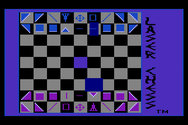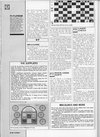|
| |
| | |
L A S E R C H E S S
---------------------
Laser Chess, as the name implies, is a chesslike strategy game for
2 players. The goal is to manipulate a laser-firing piece and
various reflective objects to eliminate your opponent's King. As
in traditional chess, there are an infinite number of ways to
accomplish this.
There are 8 basic pieces and each has unique capabilities. Over
time you will learn each piece's advantages and limitations.
If you load the program, you will see a chequered board with Red
pieces and Green pieces. Make sure the Green pieces line the top
of the board, for the purpose of identifying each piece. From
left to right:
TOP LINE
2 Triangular Mirrors, a Diagonal Mirror, The Laser, a King, a
Hypercube, a Diagonal Mirror, 2 Triangular Mirrors.
2ND LINE
A Triangular Mirror, 2 Blocks, a Beam Splitter, a Horizontal
Straight Mirror, a Vertical Straight Mirror, 2 Blocks, a
Triangular Mirror.
Notice that some sides of the pieces are highlighted (or appear
thickened on a monochrome display). This indicates a reflective
surface. When a Laser beam strikes a reflective surface, it
bounces off without harming the piece. But if a piece is hit, on
a non-reflective surface, it is destroyed.
a piece can also be removed from the board if it is captured by an
opposing piece. (Similar to traditional chess, you move one of
your own pieces onto an opponent's square.)
As well as being able to move from square to square, pieces with
reflective surfaces can also be rotated in place in 90%
increments. This allows you to orient the piece to protect it
against your opponents Laser shots.
THE KING is the most important piece. When the King has been
eliminated, the other player wins the game. Since it has no
reflective surfaces, it can be destroyed from any direction. The
King is not entirely defenseless - it can capture any opposing
piece by moving onto its square. This can only be done once a
turn.
THE LASER is the 2nd most important piece. This is the primary
offensive weapon. It is the only piece that can fire a laser
shot. To take aim, it can be rotated, but, like the King, it is
completely vulnerable to enemy Laser strikes as it has no
reflective surface. However, if you lose your Laser, the game is
not over - only the most skillful (or lucky) player can overcome
its loss!
THE HYPERCUBE is an interesing piece. It cannot harm an opposing
piece, but may well do so indirectly. When the Hypercube is moved
onto another piece (even your own), that piece disappears from its
original position and reappears on a randomly selected empty
square. This can be done only once per turn. So, the Hypercube
is a 2-edged sword; it may relocate a piece to a vulnerable
position, or make it possible for the piece to capture an
important opposing piece on the next move. It has no reflective
surfaces and cannot be rotated. It is invulnerable to Laser shots
though, being made of transparent glass (a Laser beam passes right
through it).
THE BEAM SPLITTER is another tricky piece. When a Laser beam
strikes a splitter's vertex (the point opposite its base), the
beam splits in 2 directions, perpendicular to the original beam's
path. When a Laser shot hits one of the beam splitter's
reflective surfaces, it bounces off a at 90% angle without
splitting. If the Beam Splitter's base is hit, it is destroyed.
The Beam Splitter can also be rotated.
THE BLOCKS are fairly simple pieces. However, they may impose
some complex situations. A Block can capture any opposing piece
by moving onto that piece's square, much like a King. but unlike
a King, a Block has one reflective side and can be rotated as the
situation demands. Therefore, Blocks can be used either
offensively or defensively. A Laser beam that hits the reflective
surface of a Block is deflected 180% - bouncing the beam back
where it came from.
A DIAGONAL MIRROR cannot be destroyed by a Laser, because both of
its surfaces are reflective. Diagonal Mirrors can be removed from
the board only when captured by a Block or a King. When a Laser
beam strikes a Diagonal Mirror, the beam is deflected 90%.
Diagonal Mirrors can be flipped to their opposite diagonal, but
cannot be rotated to face horizontally or vertically.
THE HORIZONTAL MIRRORS and VERTICAL MIRRORS (known collectively as
STRAIGHT MIRRORS) are also invulnerable to lasers due to their
relfective surfaces. When a Laser hits a Straight Mirror on its
flat surface, the beam is deflected 180%. But if the Laser hits a
Straight Mirror edgewise, the beam passes straight through it.
THE TRIANGULAR MIRRORS deflect Laser beams just as Diagonal
Mirrors do, but they are invulnerable to hits on their 2 non-
reflective sides. A Triangular Mirror can be rotated in 90%
increments.
MAKING MOVES
------------
All game functions are controlled with the mouse. Each player
trades off the mouse after each turn. If you have a color
monitor, you will notice that the mouse pointer changes color to
show whose turn it is.
The red player (at the bottom of the screen, unless you have
reoriented the board) always gets the first move. There is no
particular advantage or disadvantage to moving first.
A turn consists of 2 moves. The number of moves remaining, in a
turn, is indicated by the numbe of boxes in the square to the left
side of the screen.
Before moving a piece, you must 'select' it. This is done by
clicking (with the left mouse button) on the desired piece. Once
selected, it becomes highlighted. If you accidently select the
wrong piece, you can easily deselect it by clicking the left mouse
button again. (This would not cost you a move.) However, once a
piece is selected, you must decide where to move to, or how to
rotate it (rotating counts as a turn). To move the piece, simply
use the mouse pointer and click on that square. Moving one
square, counts as one turn, moving 2 squares, as 2 turns.
However, moving more than one square in one turn, counts as one
turn (the maximum is 2 squares, anyway).
Pieces can be moved forward, backward, left or right, but NOT
diagonally. You can effectively move a piece diagonally by using
2 moves (e.g. forward then right). You cannot move a piece
through other pieces except when capturing with a Block or a King
and when using the Hypercube.
To rotate a piece, select it, then firmly press the right mouse
button. The piece will rotate 90% (one-quarter turn clockwise).
You can rotate more than once, but these will cost you turns. If
you wish to forfeit a turn altogether, just position the mouse
pointer inside the box representing turns, to the left of the
screen.
SPECIAL FEATURES
----------------
At the center of the board is a special square called a
Hypersquare. it absorbs Laser beams and acts like a stationary
Hypercube. That is, if you try to move a piece there, it
disappears and reappears randomly on an empty square. This can
only be done once a turn.
To the left of the board are 4 octagonal shapes - Q, R, D and a
button colored orange. If you click in the button marked Q, you
will quit the game. If you choose R, this will let you restart
the game. If you choose D, this will let you choose the direction
of play (rotates the board 90%).
The orange button (at the base of the screen) is the Laser
trigger. When it is your turn, you can select this button to fire
your Laser. If you hold the button down for a few seconds you
will be able to see the effects of your shot. If you click the
button too quickly, the beam may disappear before you can
comprehend a complex bounce pattern. Firing the Laser takes only
one turn, but can be done only once per turn. It is important to
realise that any hit on a piece's non-reflective or non-
transparent surface, will destroy that piece. You can easily
destroy your own pieces as well as your opponent's. You can also
zap your own Laser if not careful, particularly if you fire
directly into the 180% reflective surface of a Straight Mirror or
Block, or if you fail to anticipate the effects of a Beam
Splitter.
SOME TIPS ON PLAY
-----------------
Get your Mirrors out early. Use them to gain the fullest
potential or your Laser. Try to position Mirror networks on both
sides of the Beam Splitter so you can inflict as much damage as
possible. Take advantage of the Blocks, since they 'control' an
area around them with their threat of capture, and no other pieces
can safely move within their range. Make your opponent work to
displace them. Remember to rotate the reflective side of a Block
to the most proabable direction of Laser fire. If you can prevent
a Laser from destroying the Block, your opponent will most likely
have to gang up on it with 2 or more of his own Blocks.
Use Mirrors to protect your King. If you surround your King with
Straight and Diagonal Mirrors, there is no way it can be hit by a
Laser. Therefore, your opponent will have to break through your
defense with Blocks. Defending your King with Blocks is also a
good strategy.
The Hypercube should be used sparingly, since you have no idea
where a relocated piece will reappear. Most players use the
Hupercube as a last resort - if another piece is going to be
destroyed anyway, it doesn't hurt to take a chance and relocate it
with the Hypercube. Also, if your opponent decides to encircle
his King with Mirrors, you can march right in with your
Hypercube, followed by a Block. This tactic may displace your
opponent's defense, forcing him to evacuate his King from its
Mirrored fortress. Escorting the Hypercube with an adjacent Block
prevents the opponent from attacking the Hypercube with his King.
Your opponent's only options will be to flee or be displaced. |
| |
Conversion - Atari 8-bit
 Origins
Winner of the grand prize of $5.000 in Atari ST Programming Contest sponsored by Compute! magazine.
|
| |
| ST / Amiga Format · October, 1988 | Rating: - |

|
| | | | |